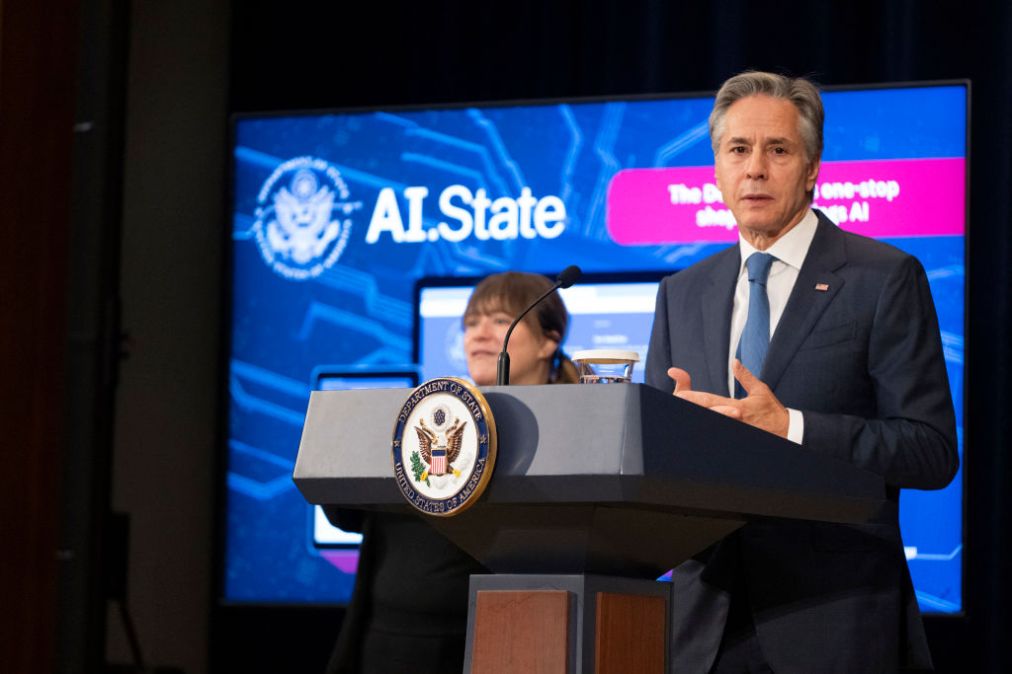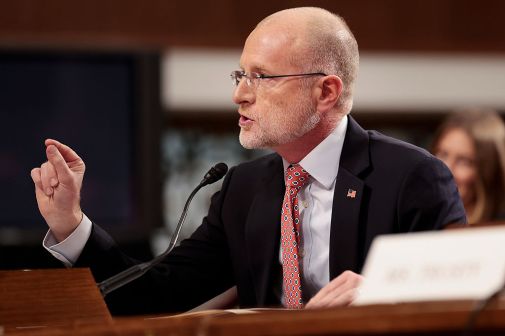AI will complement State Department’s diplomatic mission, Blinken says

With a dense artificial intelligence inventory and more use cases on the way, the State Department has embraced AI to a greater degree than many of its federal counterparts.
Secretary of State Antony Blinken is under no illusions that that embrace won’t cause concerns. Speaking Friday in Washington, D.C., before an auditorium full of State workers and hundreds on a livestream, Blinken addressed those concerns by posing an AI-related hypothetical.
“Are we going to be looking at this room in 10 or 15 years and seeing a physical manifestation of a chatbot and no one else? And the answer is, we’re not,” Blinken said. “And that’s because this technology is not a substitute for us. It’s a complement to our work. It’s an ability to make us more effective.”
Leveraging artificial intelligence for efficiency to create more time for face-to-face diplomacy was a common message throughout Friday’s State AI event, which featured Blinken in a discussion with Chief AI Officer Matthew Graviss and a panel talk with four agency officials. Blinken repeatedly stated his case that the technology is “not a threat” to State’s workforce, but rather a “critical” tool to “really free us up to focus on the value add that only we, only you, can bring to our work.”
“I know there’s a lot of anxiety whenever we’re integrating new technology into our work,” he said. But the “engagements” and “basic humanity” diplomats bring to the table “really can’t be replaced.”
With diplomatic posts in over 270 countries and myriad language needs that come with that, communication is of the utmost importance to State’s mission. Elizabeth Allen, under secretary for public diplomacy and public affairs, said AI is a game-changer in that respect. An AI media monitoring platform, for example, is projected to save 180,000 hours next year in State’s public diplomacy family alone, Allen said.
But there are human guardrails that must be in place, Allen added. She endorsed a 20-60-20 split when using an AI tool like ChatGPT: 20% on upfront work on “a really good prompt” from a human, the “middle 60% of a task” from ChatGPT, and then the last 20% for human reviews.
“We always have to be making sure that we have human checks, particularly when it comes to public communications,” Allen said.
U.S. Ambassador to India Eric Garcetti is similarly thankful for AI’s ability to improve State’s ability to communicate — especially given that he serves in a country where 90-some languages are spoken. The former Los Angeles mayor said the technology’s translation capabilities save “about 80-90% of the time of our” public diplomacy officers.
“It’s like getting double the staff overnight,” he said.
Garcetti has also seen AI used by State in India to monitor and collect air quality data in Delhi to determine whether lung health would be compromised if staffers exercised outside, and in remote rural areas, where early diagnoses of conditions such as tuberculosis and hemorrhagic fever can be flagged.
“That might be the next big outbreak that the human eye wouldn’t detect, but AI will,” he said.
Processing reports more quickly is another way AI is being used by State’s workforce. Uzra Zeya, under secretary for civilian security, democracy and human rights, pointed to her department’s annual congressional reports on international religious freedom and human trafficking, which together take about 150,000 hours a year to produce.
Teaming with State’s Center for Analytics, Office of Management Strategy and Solutions, and Office of the Chief Information Officer, Zeya’s office launched an AI data collection management tool that they estimate will reduce the tens of thousands of hours spent on researching and fact-checking those reports by a third.
That reduction, Zeya said, “will free up” the time of State staffers “to get from behind their screens into the arena, to help move the needle on some of our most pressing human rights, human trafficking, religious freedom concerns around the world. … I think this is an example of technology supporting, not supplanting, our work.”
Cables can also be synthesized much more quickly with AI, Graviss noted, while a program called NorthStar in use at the agency is able to ingest scores of news articles around the world and immediately translate and deliver a cogent picture of what’s happening to the right diplomat or analyst.
AI provides State with “the ability to process just so much more data,” Graviss said. “Our team across the globe is producing communications, thousands a day, and the ability to synthesize that is paramount given the multiplicity of challenges and complexity of challenges.”
Picturing how the State Department will be using AI a decade from now would be best for someone with “a much better imagination,” Blinken said, but the secretary does believe that the technology will be “totally, thoroughly, fully integrated” in the agency’s daily work. Until then, he has a simple message for how State’s workforce should be approaching AI.
“Nerd out,” Blinken said. “Go ahead. Everyone has their inner nerd somewhere. So nerd out on this and see where it takes you.”






